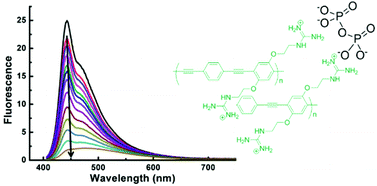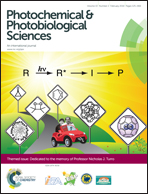Conjugated polyelectrolytes with guanidinium side groups. Synthesis, photophysics and pyrophosphate sensing†
Abstract
Two cationic poly(phenylene ethynylene) conjugated polyelectrolytes (CPEs) featuring guanidinium side groups were the subject of investigation. Two polymers were examined, one is an alternating co-polymer (P1) in which the guanidinium groups are on every other repeat unit and the second is a homopolymer with the guanidinium groups on every repeat unit. The photophysical properties of the CPEs were investigated in CH3OH and H2O solution by absorption, steady-state fluorescence and fluorescence lifetime spectroscopy. The results indicate that P1 and P2 are molecularly dissolved in CH3OH solution; however, in water the polymers aggregate as evidenced by a substantial reduction in the fluorescence yield. Addition of the non-ionic surfactant (Triton X-100) into the weakly fluorescent aqueous solution of P1 increased the fluorescence by forming a polymer/surfactant complex. The fluorescence of the polymer/surfactant complex in aqueous solution was effectively quenched by the addition of pyrophosphate (PPi) with Stern–Volmer quenching constants (Ksv) ∼ 1.7 × 105 M−1; the quenching occurs because PPi binds to the guanidinium groups and induces the aggregation of the polymer/surfactant complex. In addition, by using fluorescence correlation spectroscopy it was found that the diffusion time of the aggregated complex is increased 9-fold in comparison with the free CPE/surfactant complex. A sensor is developed utilizing the significant changes in fluorescence induced by the addition of PPi.

- This article is part of the themed collection: Dedicated to the memory of Prof. Nicholas J. Turro

 Please wait while we load your content...
Please wait while we load your content...